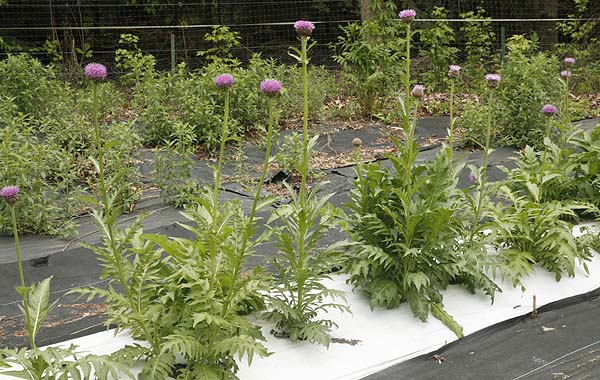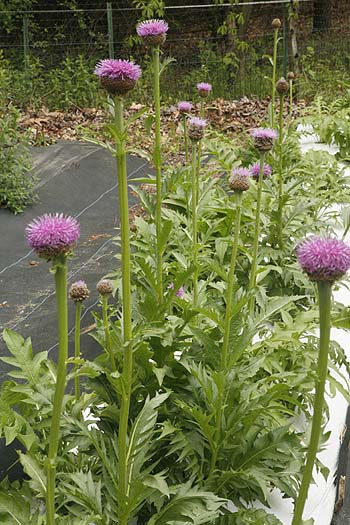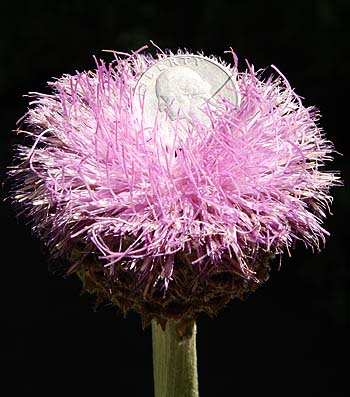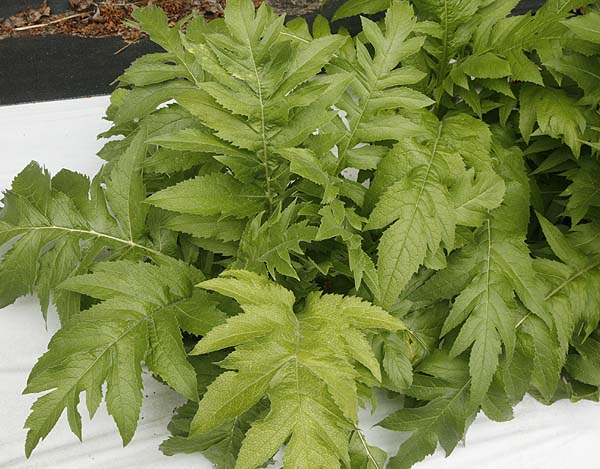This is a really lovely plant. It has lush leaves and wonderful large purple flowers in springtime. It is extremely hardy and takes very little care once established. Needs full sun and a cool location. Will not do well in hotter areas. However the deer to like to eat it so it will need protection. No cooler garden should be without this beauty, and its not easy to find.
Description of Maral Root (Rhaponticum carthamoides)
A large perennial plant for cooler regions. Produces a large rosette of large
mid green leaves that can be up to 2 feet long and are deeply incised with pointed
edges. In late spring it puts up thick round stems up to two feet tall topped
by large solitary purple flowers that can be three inches across. Plants produce
many stalks with the large showy thistle like flowers. Flowers in the second
year from seed and sends down large thick roots which strongly establish the
plant in the ground. Very hardy Zones 2-7.
Location and care of Maral Root (Rhaponticum carthamoides)
This plant is a native of Siberia thus it is used to colder climates for those
in zones 2-4 there should be no problem growing the lovely plant pick in any
full sun position. Zones 6 and 7 need to choose more carefully. Pick a location
that will shelter it from the heat of the summer sun but also give as much sunshine
as possible. The north side of a building, north side of some trees perhaps.
Somewhere there is airflow to keep it a little cool is essential.
Whatever you decide choose your location wisely. If the plant is happy it will
settle in and send down ROOTS. These guys are not easy to move once they are
settled. They produce lots of wiry roots and thicker tubers which can be very
hard to dig out.
It prefers a good fertile soil that is fairly well drained. Adding a lot of
organic material to the soil will produce a good healthy plant and it will grow
in almost any soil type if it is mulched. Will grow in clay provided it does
not become too waterlogged over the winter. Well drained is best. It also needs
reasonable water, use a soaker hose or water once a week in summer months, don't
let it dry out. Plant where the deer cant get to it, they will eat it to the
ground.
Space plants about 2 feet apart as it grows quickly and will take up quite a
bit of space.
Once established it needs little or no maintenance. Ensure it has enough water
and enjoy the blooms every spring. Clear away leaves in fall and that's it.
Growing of Maral Root (Rhaponticum carthamoides) from seed
Sow in individual pots in mid winter for spring planting. Will germinate at
fairly low temperatures so heat should not be applied. A cold frame or unheated
indoor area is ideal. Some reports say seeds benefit from cold before sowing,
all our seeds have been cold treated. Germination is usually within 2-3 weeks
depending on conditions. Best temperatures are between 55 - 60 F. This can take
2-3 weeks or more depending on temperature, warmer temperatures can inhibit
germination or produce very poor results. Grow on until large enough to plant
outside, preferably after danger of frost has passed to ensure plants can establish
well. Don't plant where deer can eat them.
Pick location well as the roots grow deep and they might not be easy to move.
Medicinal Uses of Maral Root (Rhaponticum carthamoides)
The roots of this plant have been used by Russian athletes for many years. They
contain a substances called ecdysteroids which have anabolic-like growth promoting
effects without the side effects associated with drugs . These substances are
known as adaptogens. These can helps athletes increase endurance, reflexes an
concentration, and helps them to recover faster from exertion. Studies show
that the root extract greatly increases the work capacity of muscles and normalizes
blood sugar levels quickly after exertion, and improves memory and learning.
Digging the roots and processing however is quite difficult and time consuming.
What is it called again?
Scientists can't seem to make up their minds what this plant should be called.
It used to be know as Leuzea carthamoides and
Leuzea rhapontica. Now it's Stemmacantha
carthamoides in some places and Rhaponticum carthamoide in others. It has also
been listed under Centaurea, Cirsium, and Cnicus. We are not entirely sure where
the plant stands at the moment but it would be nice if there was some consensus
and they would stop changing the darn name!










